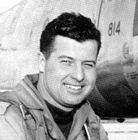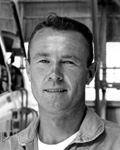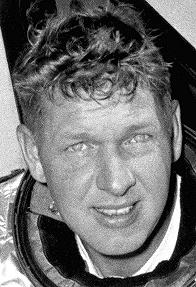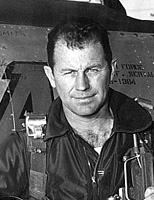The Mission > home

|
|
|
|
|
|
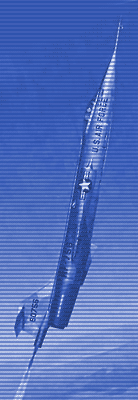 |
The Mission click on the links below for more of the story...
|
||||||||
2 The Test PilotsThe following are recollections of Lt. Col. Robert W. Smith, author of the Website, who was assigned as the Air Force Test Pilot for the AST and flew more flights and more maximum zooms flights (14), to the highest levels and under space control, than any other pilot... After about seven months flying with Fighter Test Operations I was still one of the novices, even though I had three years of prior test experience, a B.S. in Aeronautical Engineering, graduated Test Pilot School and ARPS. Joining the club was not an easy matter. I had been sent to the North American Aviation Plant in Columbus, Ohio to do some typical AFFTC “new head” work on a ground simulator in which a cockpit was driven rapidly up and down with high “g” forces and as much as 15 feet of motion. I learned the hard way that there was a faulty interface between a series of computers. I would spend two hours ‘flying supersonically on the deck’ in ever increasing turbulence to provide data needed for future design of cockpits and flight control systems. It was also to study the ability of the pilot to endure the physical effects and to ascertain whether pilot performance, when flying on instruments, would be impaired. I expect these studies were of some benefit to the F-15E and their automatic attack systems, LANTIRN, today. At the time I just but wanted to get back to the flight line and a real cockpit. On one mission a sudden max g excursion from top to bottom and back up occurred, causing a whiplash, which really hurt my neck and back. It was attributed to interference from interconnected computers. As days passed it got so bad I was in traction, without relief. My back problem grew so severe that it became hard to bear and I lost feeling and strength on the ulnar side of my right arm. After hospital treatment with constant traction had failed I was transferred to Air Force hospital in San Antonio, where each specialist concluded different treatments were in order, even surgery from the orthopedic surgeons. I returned home, no better for the trip. I was back in the hospital, having gotten nowhere for a month. I had the worst case of “good news-bad news” of my life while lying there in pain. Col. Clayton L. Peterson, my first squadron commander who, as the Director of Flight Test reported to Center Commander, B/General Branch, came to me in the hospital to let me know that I was selected to be the Air Force’s test pilot for the NF-104A, AeroSpace Trainer, but he would not be able to hold the job without my speedy recovery. As it would turn out, I was test director also by default of interest and budget in the Engineering Department. Searching for a solution in a panic, I thought of Dr. Larry Lamb, who ran the Air Force’s teaching hospital for Flight Surgeons. I had studied under his people during a special ARPS course and knew he was powerful in Air Force medical circles, and he was Vice President Lyndon Johnson’s heart specialist at that time. He had noticed my special interest in our training because he sent me a textbook on human physiology with the inscription, “Quack Smith, Regards, Larry Lamb.” I also was aware that, as head of the school where MD’s earned flight surgeon status, he had a lot of clout in non-routine decisions on medical groundings and releases. I put in a last ditch call to him. Overnight, he arranged for me to fly to Texas where I was treated by Dr. Janet Travell, President Kennedy’s doctor, who flew there from Washington as a favor to Larry. She proved to be unique in correcting back problems (as the President must have known) and had me fixed and back on flying status in a few days. She treated me with shots in the back two days running that others had tried, unsuccessfully. Their injection needles felt like pinpricks. After deftly finding the exact point by touch, her shots sent me through the ceiling, and afterward she described my exact process of healing … to a tee. I was recovered sufficiently in a few days to be reinstated for flying! Not long after that, I got another wild idea and called on Dr. Lamb one last time on behalf of a great guy, my next-door neighbor, whose need for help was more critical than mine. Capt. Phil Neale, test pilot and TPS graduate had been medically grounded for life, with all courses of appeal exhausted, due to a heart problem induced by a staphylococcus infection. That time I enticed Larry with the promise of a gourmet dinner, and Martha is one who could deliver on that promise. He flew to Edwards for dinner at our home with Phil and Barbara. Phil was released back to flying status in short order and became a major player in our most widely reported AST event. He was a changed man, so happy to return to the flying. He died testing a new French helicopter but I know he had replaced a life of despair and accepted such risk for the life he relished, as so many of us did. Years later, Larry Lamb wrote a nationally syndicated column on medical enquiries by readers. He once told me that he had graduated from Medical School at age 21, and had to study in Switzerland because of age restrictions in America’s schools. Larry Lamb was one smart fellow to whom I owe special appreciation for the opportunity to fly such an exciting project. I will always cherish the memory of my friend Clayton “Pete” Peterson, as an outstanding leader in my first fighter squadron, the 27th, and for being such a fine gentleman, and wonderful friend. I owe him for exciting flying experiences when he selected me for the AST. I know deep down he arranged that and that Jackson Saunders, my Flight Commander in the 27th, was also instrumental in the long run. They were good friends from WW II days and Jackson passed along my flying exploits in Rome NY, I have no doubt. I suspect it was difficult and involved Pete’s taking risks to get the general’s approval over more senior pilots at Edwards. I learned that I would join Jack Woodman, a test pilot of the Lockheed Aircraft Company, which designed and built the F-104 Starfighter aircraft, flying in the contractor’s test program before I would go it alone with the Air Force testing. Jack was born in Canada on 14 May 1925 and joined the Royal Canadian Air Force as an aerial gunner in 1944. He completed 23 combat missions in Europe during WW II, went to college a couple of years and re-enlisted in the RCAF for flying training. He completed training and flew Air Rescue, until selected for test pilot school at Farnborough, England, from which he graduated in 1952. After flight test duties with the RCAF, including testing at Lockheed, Jack joined that company as an engineering test pilot in August 1962.
Test programs on new airplanes were flown jointly with the contractor pilot having primary role, and then turned over entirely for Air Force to complete. The latter testing was generally much longer in duration. The test program for the AeroSpace Trainer, NF-104A, was more abbreviated than usual but was organized as if a new aircraft because of the many and significant physical differences and especially the great expansion of the operating limits. The initial testing was done as a traditional Joint Contractor/Air Force. There were 38 test flights to gain the first understanding of effects from the significant modifications and satisfy the contract obligations. Considering the significance of the changes the program was unusually brief, with the intent of increasing the Air Force test role for contract cost reductions. Jack flew all but 7 of the test flights, which I flew..
I was the only test pilot on the Air Force project, which was unexpectedly limited to 13 Maximum Performance climbs (Max Zooms), I flew those and a 20 minute flight for publicity photos, which was a low altitude, low speed simulated space flight, with rocket propulsion and 70 degree climb angle. This very austere testing did not do justice to my plan, which was for incremental expansion of the flight envelope. It was the result of a surprising decision by the Air Force Chief of Staff which led to much worse than just a change of plans. And that decision extended my testing by an additional 105 test flights, to a total of 126 flights in the AeroSpace Trainer (NF-104A
As a result of the same event Maj. Bob Rushworth flew one flight on a high performance climb to provide a second opinion on the airworthiness of the airplane, before the next event unfolded. Bob was the primary pilot on the X-15 rocket research airplane and ultimately flew far more flights in that airplane than any other pilot. Bob was a graduate engineer, who had flown the “hump” in the C-46 cargo airplanes in WW II, joined the National Guard, and rejoined the Air Force after college was completed. Bob had been drafted into the Army in 1944, trained in Aviation Cadets and joined the Army Air Corps as a C-46 pilot, flying the Hump, over the world’s highest mountains with heavy loads from India to China. Separated after the war, he joined the Air National Guard and was recalled for service and his permanent career and climb to Major General began.
The Air Force tests were suddenly stopped as a result of a very unexpected decision. It was traditional that the lead A.F. test pilot would make any record flight attempts on that project, so I was considered a shoo-in, especially by the Director of Flight Test, who had picked me for the job but had the unpleasant task of advising me to the contrary, when he was told that Col. Chuck Yeager would be given the honor of attempting to set an official World Altitude Record. It was that decision that began Chuck’s brief and noteworthy difficulties in the aircraft, which engendered an extended new test program and the outcome of AeroSpace Trainers’ use in training.
|
| previous section | next section |
